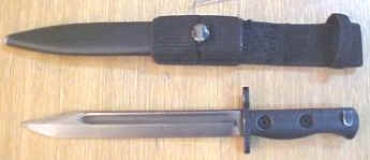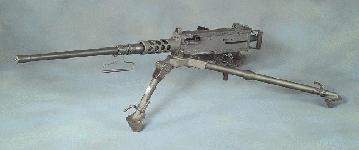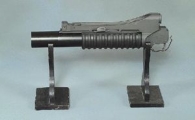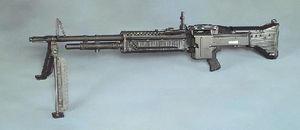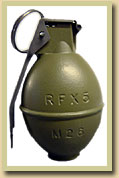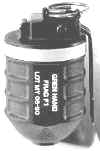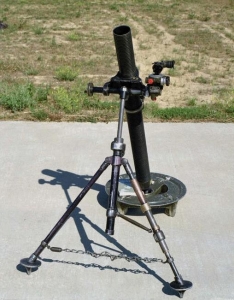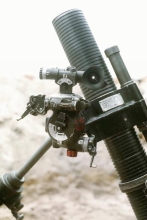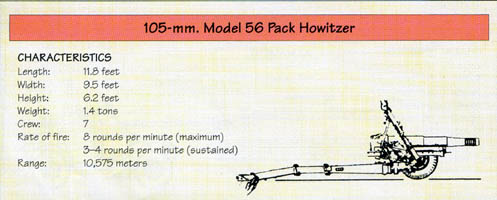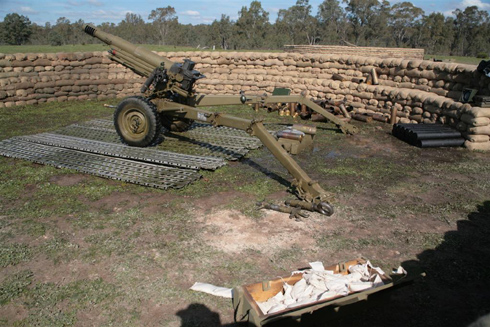
 |  | ||
 |
|
 | |
 |  |
Browning Hi-Power
|
|
The Browning Hi-Power is a semi-automatic, single-action, 9 mm pistol. It is based on ideas conceived and patented in 1922 by American firearms inventor John Browning, and later patented by Fabrique
Nationale d'Armes de Guerre (FN) of Herstal, Belgium. Browning died in 1926, before he had finished developing a production version. The design was fully developed and realized by Belgian arms designer
Dieudonne Saive, working at FN.
The Hi-Power pistol was named for its 13-round magazine capacity, which was almost twice that of contemporary designs such as the Luger or Mauser 1910. The Hi-Power had the first functional doublecolumn
magazine of 9 mm Parabellum rounds, and was capable of holding 13 cartridges, with a 14th loaded in the chamber. Flush-fit 15 round magazines are now available, as well as higher capacity magazines which extend past the end of the magazine well.
The Browning 9-mm pistol is carried by officers and soldiers who require a sidearm that can be rapidly drawn and fired, even in confined spaces. The pistol consists of a barrel, a slide, a breech block, a frame,
and a 13 round magazine.
Weight: 1 kg (with empty magazine)
Length: 19.69 cm
Barrel length: 12.38 cm
Operation: recoil operated, semi-automatic
Feed: 13-round detachable magazine
Sights: Rear - fixed square notch, Front - tapered post
Sight Radius: 159mm
Muzzle Velocity: 350 m/s
L1A1
|
|
The L1A1 is the Australian version of the Belgian FN FAL rifle. It entered into service with the Australian Army in 1959. The L1A1 was a reliable, hard-hitting, gas-operated, magazine-fed semi-automatic rifle, with a maximum battle range of 300 metres and a practical rate of fire of 20 rounds per minute. In Vietnam the L1A1 was the standard personal weapon of the Australian soldier. With a full 20 round magazine it weighed 4.96Kg. The standard issue was 5 magazines per rifleman but almost all carried as many filled magazines that they could get their hands on, often dispensing with food rations in order to find room for the extra ammunition. The rational to this was that the extra 7.62 mm rounds fired from an SLR rifle would do more damage than throwing a can of Ham and Lima Beans.
Type: Battle rifle
Place of origin: Belgium
Wars: Cold War, Vietnam War, Falklands War
Designed: 1951
Manufacturer: Fabrique Nationale (FN)
Produced: 1953—
Number built: Over 1 million
Weight: 4.0–4.96 kg (8.8–10.2 lb)
Length: 1,090 mm (43 in)
Barrel length: 533 mm (21 in)
Cartridge: 7.62 × 51 mm NATO
Calibre: 7.62 mm (.308 in)
Action: Gas-operated, tilting block
Rate of fire: 20 rounds/min semi auto
Muzzle velocity: 823 m/s (2,700 ft/s)
Effective range: 600 m (656 yd)
Feed system: 20-round detachable box magazine
Sights: Aperture rear sight, hooded post front sight
Bayonet and scabbard for the SLR
|
|
Bayonet and scabbard for the SLR. Blade length approx 8 inches.
The Browning .50 Machine Gun
|
|
The Browning .50 machine gun was used extensively as a vehicle weapon and for aircraft armament
by the United States from the 1920s to the present day. It was heavily used during World War II, Korean
War, the Vietnam Conflict, as well as during operations in Iraq in the 1990s and 2000s. It is the primary
heavy machine gun of NATO countries, and has been used by many other countries. It is still in use
today. Its primary role was as a perimeter defence weapon for the 1st Australian Task Force.
Type: Heavy machine gun
Place of origin: United States of America
Designed: 1921
Produced:1932-
Weight: 38 kg (58 kg wi tripod)
Length: 1,650 mm (65 in)
Barrel length: 1,140 mm (44 7/8 in)
Cartridge: .50 BMG
Calibre: .50 in (12.7 mm)
Action: Recoil-operated; short recoil
Rate of fire: 550 round/min
Muzzle velocity: 3,050 ftls (930 m/s)
Effective range: 2,000 m (2200 yards)
Feed system: Belt-fed
The Owen
|
|
The Owen was the only Australian-designed service firearm of WWII. Evelyn Owen, an inventor from Wollongong, was 24 in July 1939 when he presented his prototype "Machine Carbine" to ordnance officers at the Victoria Barracks in Sydney.
Although somewhat bulky the Owen rapidly became very popular due to its reliability. It was so successful that it was ordered by the US and New Zealand. The Owen was used in front-line service in the Korean and Vietnam Wars. It remained a standard weapon of the Australian Army until the early 1960s, 1RAR, 5RAR and 6RAR on their first tours carried the weapon to Vietnam when it was finally declared to be unsuitable and was replaced with the American M15 and M16 automatic rifles.
Design: 1939
Place of origin: Australia
Number Built: 50,000 '"
Weight: 4.21 Kg (9.37Lb)
Length: 806 mm (32 in)
Barrel Length: 247mm (9.75 in)
Cartridge: 9 mm Parabellum
Calibre: 9 mm
Action: Blowback
Rate of Fire: 700 round/Min
Muzzle Velocity: 420m/sec (1250 ft/sec)
Feed System: 32 round detachable box magazine
M72A2 Rocket Launcher
|
| |
|
|
The weapon consists of a rocket packed inside of a launcher made up of two tubes, one inside the other. While closed, the outer assembly acts as a watertight container for the rocket and the percussion cap-type firing mechanism that activates the rocket. The outer tube contains the trigger, the arming handle, front and rear sights, and the rear cover. The inner tube contains the channel assembly which houses the firing pin assembly, including the detent lever. When extended, the inner tube telescopes outward toward the rear, guided by the channel assembly which rides in an alignment slot in the outer tube's trigger housing assembly. This causes the detent lever to move under the trigger assembly in the outer tube, both locking the inner tube in the extended position and cocking the weapon. Once armed, the weapon is no longer watertight even if the launcher is collapsed into its original configuration.
When fired, the propellant in the rocket motor completely combusts before leaving the tip of the launcher, producing gases around 1,400 OF(760°C). The rocket propels the 66 mm warhead forward
without significant recoil. As the warhead emerges from the launcher, 6 fins spring out from the base of the rocket tube, stabilizing the warhead's flight. Once fired the launcher is no longer useful and may be
discarded. 5RAR soldiers used the M72 primarily against enemy bunker systems.
Launcher
Length: Extended: less than 1 m (34.67 in). Closed: 0.67 m (24.8 in).
Weight: Complete M72A2: 2.3 kg (5.1 Ib).
Firing mechanism: Percussion.
Front sight: reticle graduated in 25 m range increments.
Rear sight: peep sight adjusts automatically to temperature change.
Rocket
Calibre: 66 mm (2.6 in)
Length: 508 mm (20 in).
Weight: 1.8 kg (2.2 Ib).
Muzzle velocity: 145 m/s (475 ftIs).
Minimum range (combat): 10 m (33 ft).
Minimum arming range: 10m (33 ft).
Maximum range: 1,000 m (3,300 ft).
Maximum effective ranges
Stationary target: 200 m (220 yd)
Moving target: 165 m (180 yd)
Beyond these ranges, there is less than a 50 % chance of hitting the target.
M18A1
|
|
The M18A1 was standardized in 1960 for the Vietnam War. Its primary use was in perimeter defences and ambushing. The M18A1 comprised of a curved rectangular cast-iron box with spikes fitted to the base. It has an olive coloured plastic casing with the words "Front Toward Enemy" on it. It has two sets of adjustable legs. It is equipped with a knife edge style sight on currently fielded models (older models featured a fixed
plastic slit-type sight which was not as effective for aiming and resulted in the mine being aimed too low, shortening the blast radius) and two detonator wells.
The weapon and all its aCGessories are carried in the M7 bandolier. An instruction sheet for the M18A 1 is attached to the inside cover of the bandolier.
Weight: 1.6 Kg (3.5Lbs)
Length: 21.5 cm (8 in)
Height: 8 cm (3 in)
Propellent: 680gms (1.5Lbs) composite C4 plastic explosive
Fragmentation: 700 steel ball bearings
Initiator: No 2 electric blasting cap
M16A1 and M203
The combination M16A1 automatic rifle and M203 ( a version of the M79) grenade launcher was produced to avoid the problem of a infantryman having to carry a grenade launcher as well as a weapon for personal protection. While both weapons were used separately by infantry sections, the combination was used extensively by SAS troops.
7.62mm GPMG M60
|
|
|
|
The 7.62mm GPMG M60 general purpose machine-gun an American produced weapon that came into service with the Australian Army in 1960, can be employed in a light role on it's bipod (effective range 500 metres) or in a medium role on a tripod (effective range 1,100 metres) as well as being used as protective armament on vehicles and helicopters. Gas operated, air cooled and belt fed, with a quick-change barrel to counter overheating during sustained firing, it has a practical rate of fire of 200 rpm. In Vietnam it was the main firepower of the infantry rifle section. With bipod the M60 weighs 10.5 kg, which increases by 6.8kg if a tripod is added. It is slowly being replaced by the F-89 Minimi
M26 Grenade
|
|
The M26 series is in many ways an upgrade in basic principle of the Mk II. A similarly shaped, but not visibly ribbed fragmentation grenade. The M26 has a filling of Composition B contained within a sheet steel two part outer shell which covers a pre-notched fragmentation coil inner liner. The use of the inner
liner creates a highly predictable fragment pattern and causality radius. The grenade was found to have problems with complete detonation of the filler, and the M26A 1 featured a tetryl booster to ensure complete detonation.
Weight: 425g
Average Throwing Distance: 40m
Blast Radius: 10m
Killing Distance: 5m
Wounding Distance: 25m
Issue: 2 per infantry soldier
Replaced by . . .
The Australian F1 grenade
|
|
Claymore
|
|
The design for the Claymore mine was originally conceived by the German Army during WW2. The original mine consisted of a solid slab of explosive with a hollowed front face. The concave surface of the mine was lined with a solid brick of steel and was originally intended as an anti tank mine. When detonated the explosive force was enough to throw the steel brick forward with enough power and velocity to penetrate a tank's armour plating at ranges up to 50 meters. However the Germans never fully perfected the weapon. Instead it was left to the US Army to expand on the idea in response to the massed North Korean, and Chinese attacks that US soldiers faced during the Korean war. US ordnance experts developed the idea of a mine that would propel hundreds of small pieces of steel in one - go thereby causing maximum casualties among the enemy. However trials of this experimental mine were not completed before the Korean war ended.
By the time of the Vietnam war 65-75 the mine had been fully developed, with the version used in Vietnam being the M-18A1.The mine had an olive-drab coloured outer casing with the words "Front Toward Enemy" embossed on it and was made from plastic which measured 216mm long, by 83mm high, and was 35mm deep. Inside the casing was 0.68Kg of C-4 plastic explosive in front of which was placed 700 steel ball bearings. Designed so the convex side faced the enemy, and steadied by digging a twin set of "V" shaped legs into the earth. When detonated the blast sprayed its contents in a 60 degree fan-shaped arc that was lethal up to 50 meters. The mine could be either command detonated by using the hand held "clacker" (or a PRC 25 battery) which sent an electrical charge through the wire to the blasting cap inserted in the mine, or detonated by trip wire.
When arranged in fixed defensive positions Claymore's were arranged so as to have overlapping kill zones. It was also a very effective tool for initiating ambushes due to the instant devastating, and lethal zone generated. And also because it did not reveal the whereabouts of the ambush team.
M18 Smoke Grenade

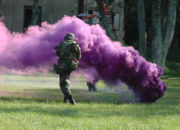
|
|
Although not a weapon, nevertheless smoke grenades saved the lives of many
Australians by marking directly the location for the 'Dust Offs' (casualty evacuation
helicopters) and giving wind information. Also when in close contact with the
enemy, 'smoke' was also used to 'mark' the Australian position so that air support
would know the
M79
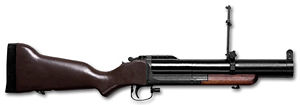
The M79 is a 40 x 46 mm grenade launcher that first appeared during the Vietnam war.
Commonly known as the "Thump-Gun", "Thumper", or "Blooper" in US service, it is also
known to some Australian units as the "Wombat Gun".
Resembling a sawn-off shotgun, the grenade launcher was designed as a closesupport
weapon for the infantry. It plugged the gap between the maximum throwing
distance of a hand grenade and the lowest range of supporting mortars. The M79 was a
single shot, shoulder-fired weapon which broke open for loading into the breech. It fired
a 40 mm grenade and had a killing range of 5 metres. Its weight loaded, was 3Kg, with
a muzzle velocity of 75 metres per second and a maximum range of 400 metres.
Type: Grenade launcher
Weight: 8.10 kg (17.81 Ibs)
Length: 737 mm (29 in)
Barrel length: 355 mm
Cartridge: 40 mm grenade
Action: Single shot, breech loaded
Rate of fire: Single shot
Effective range: 50-300 metres
Feed system: Single shot, breech loaded
Sights: Iron sight
Muzzle Velocity: 75 metres per second
Radius: Enough explosive within a steel casing that upon impact with the target would produce over 300
fragments at 1,524 metres per second within a lethal radius of up to 5 metres.
Arming Device: Stabilised in flight by the spin imparted on it by the rifled barrel, the grenade rotated at
3,700rpm, this in turn after approximately 15 meters of flight armed the grenade.
M-29 81mm Mortar
|
|
|
|
The M-29 81mm Mortar, is a smooth-bore, muzzle-loaded, high-angle, indirect fire weapon.
It consists of a barrel, sight, bipod, and base plate. The M-29 has a greater range, and its circular base plate allows for firing in any direction. High Explosive (HE) Fragmentation and blast. Causes troop casualties and damage to light material. Red Phosphorus (RP), White
Phosphorus (WP) Smoke. Used to screen, signal, and act as an incendiary.
Illumination:
Used to illuminate, signal, and mark.
Ammunition: 81 mm
Max Range: 6,500 m
Crew: 3
Weight: 40-52 kg
RPM: 15
105-mm. Model 56 Pack Howitzer
|
|
|
|
(photo © Defence Material Organisation)
CHARACTERISTICS
Length: 11.8 feet
Width: 9.5 feet
Height: 6.2 feet
Weight: 1.4 tone
Crew: 7
Rate of fire: 8 rounds per minute (maximum)
3-4 rounds per minute (sustained)
Range: 10,575 meters
APC
|
|
Type Armored personnel carrier
Place of origin United States
Service history
In service 1960 -
Used by Numerous nations, see'text
Wars Vietnam War, others
Production history
Number built -80,000 (all variants)
Variants Numerous, see text
Specifications
Weight 12.3 tonnes
Length 4.863 m
Width 2.686 m
Height 2.5 m
Crew 2 + 11 passengers
Armor aluminium 12-38 mm
Primary
Armament M2 Browning machine gun
Secondary
Armament varies (see text)
Engine Detroit Diesel 6V53T, 6-cylinder diesel engine
275 hp (205 kW)
Power/weight 22.36 hp/tonne
Suspension torsion bar, 5 road wheels
Operational
Range -480 km (-300 miles)
Speed 66 km/h (41 mph)
|
|
|
|


































